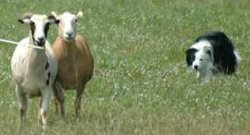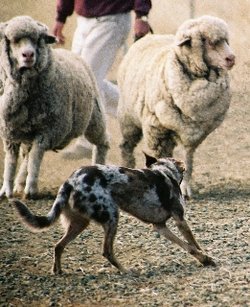 A Border Collie at work
with goats.
A Border Collie at work
with goats.
|
From Wikipedia the free encyclopedia, by MultiMedia |
 A Koolie working with sheep.
A Koolie working with sheep.
A herding dogor pastoral breed is a dog that either has been trained in herding or that is a member of a breed developed for herding. Some herding breeds work well with any kinds of animals; others have been bred for generations to work with specific kinds of animals and have developed physical characteristics or styles of working that enhance their ability to handle these animals. Commonly herded animals include cattle, sheep, and reindeer.
Herding dog is also sometimes used to refer to dogs whose primary job is to guard the herd from predators and to be sure that it does not go astray. A Maremma Sheepdog is an example. For more information about dogs of this type, see Livestock guardian dog.
In general terms when categorizing dog breeds, herding dogs are considered a subcategory of working dogs, but for dog shows they usually form a separate group.
 A Border Collie at work
with goats.
A Border Collie at work
with goats.
Dogs can herd other animals in a variety of ways. Some breeds, such as the Australian Cattle Dog, typically nip at the animals' heels (for this reason they are called heelers). Others, notably the Border Collie, get in front of the animals and use what is called eye to stare down the animals; they are known as headers. The Koolie has been observed to use both these methods and to jump on the backs of their charges. Koolies are therefore said to 'head', 'heel', and 'back'.
All herding behavior is modified predatory behavior.
Most herding breeds have physical characteristics that help them with their work, including speed and endurance. Shorter breeds, such as Welsh Corgis, were bred so that they would be out of the way when cattle, their primary charges, kicked at them.
Due to their intelligence and beauty, herding dogs are often chosen as family pets. It is important to remember that these dogs have been bred to work, and must be kept active. Herding breeds will herd family members, particularly children, in the absence of other charges.
Herding breeds include the following:
Dogs, made by MultiMedia | Free content and software
This guide is licensed under the GNU Free Documentation License. It uses material from the Wikipedia.